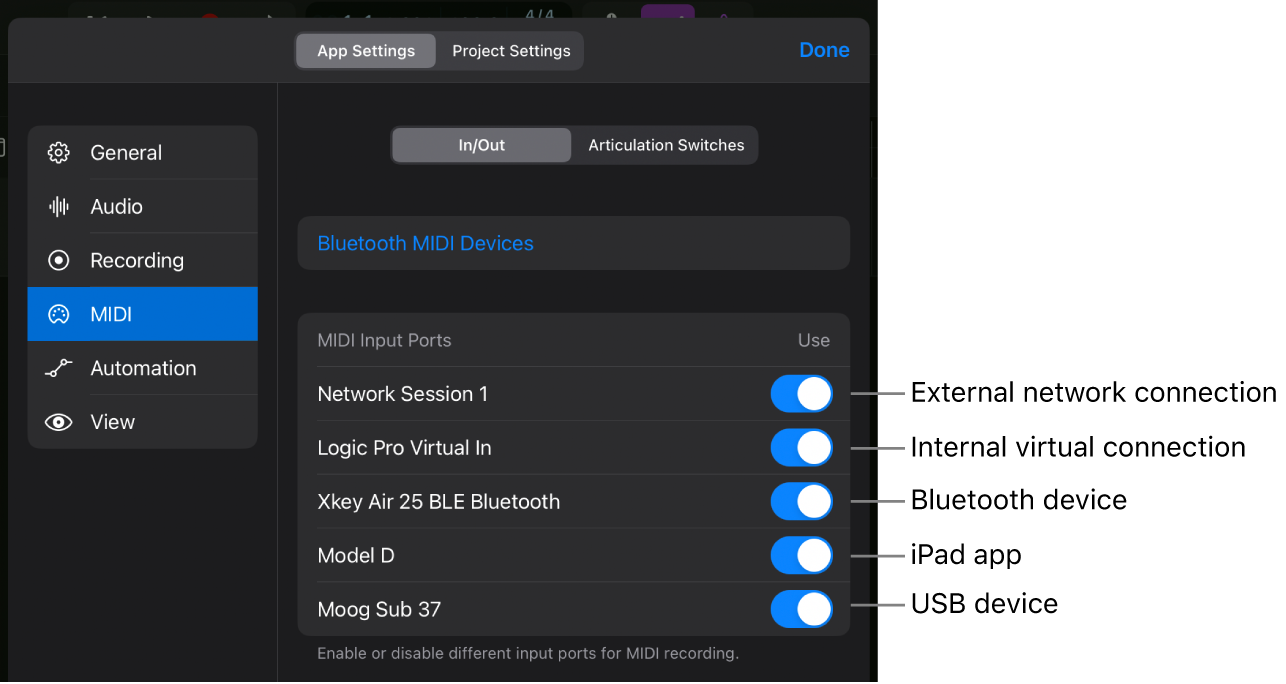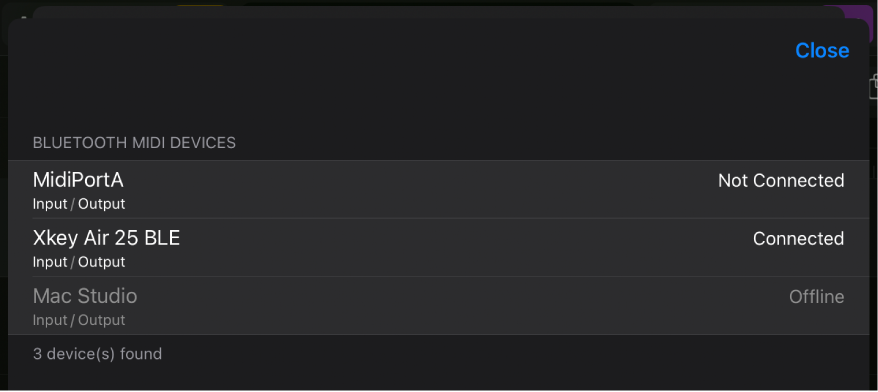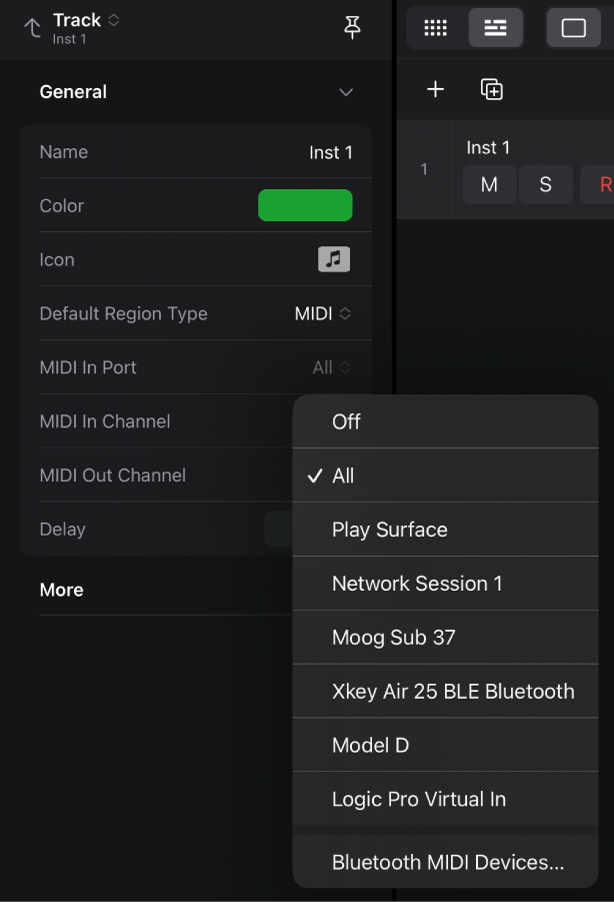Logic Pro User Guide for iPad
-
- What is Logic Pro?
- Working areas
- Work with function buttons
- Work with numeric values
-
- Intro to tracks
- Create tracks
- Create tracks using drag and drop
- Choose the default region type for a software instrument track
- Select tracks
- Duplicate tracks
- Reorder tracks
- Rename tracks
- Change track icons
- Change track colors
- Use the tuner on an audio track
- Show the output track in the Tracks area
- Delete tracks
- Edit track parameters
- Start a Logic Pro subscription
- How to get help
-
- Intro to recording
-
- Before recording software instruments
- Record software instruments
- Record additional software instrument takes
- Record to multiple software instrument tracks
- Record multiple MIDI devices to multiple tracks
- Record software instruments and audio simultaneously
- Merge software instrument recordings
- Spot erase software instrument recordings
- Replace software instrument recordings
- Capture your most recent MIDI performance
- Use the metronome
- Use the count-in
-
- Intro to arranging
-
- Intro to regions
- Select regions
- Cut, copy, and paste regions
- Move regions
- Remove gaps between regions
- Delay region playback
- Trim regions
- Loop regions
- Repeat regions
- Mute regions
- Split and join regions
- Stretch regions
- Separate a MIDI region by note pitch
- Bounce regions in place
- Change the gain of audio regions
- Create regions in the Tracks area
- Convert a MIDI region to a Drummer region or a pattern region
- Rename regions
- Change the color of regions
- Delete regions
- Create fades on audio regions
- Access mixing functions using the Fader
-
- Intro to Step Sequencer
- Use Step Sequencer with Drum Machine Designer
- Record Step Sequencer patterns live
- Step record Step Sequencer patterns
- Load and save patterns
- Modify pattern playback
- Edit steps
- Edit rows
- Edit Step Sequencer pattern, row, and step settings in the inspector
- Customize Step Sequencer
-
- Effect plug-ins overview
-
- Instrument plug-ins overview
-
- ES2 overview
- Interface overview
-
- Modulation overview
-
- Vector Envelope overview
- Use Vector Envelope points
- Use Vector Envelope solo and sustain points
- Set Vector Envelope segment times
- Vector Envelope XY pad controls
- Vector Envelope Actions menu
- Vector Envelope loop controls
- Vector Envelope release phase behavior
- Vector Envelope point transition shapes
- Use Vector Envelope time scaling
- Use the Mod Pad
- Modulation source reference
- Via modulation source reference
-
- Sample Alchemy overview
- Interface overview
- Add source material
- Save a preset
- Edit mode
- Play modes
- Source overview
- Synthesis modes
- Granular controls
- Additive effects
- Additive effect controls
- Spectral effect
- Spectral effect controls
- Filter module
- Low and Highpass filter
- Comb PM filter
- Downsampler filter
- FM filter
- Envelope generators
- Mod Matrix
- Modulation routing
- Motion mode
- Trim mode
- More menu
- Sampler
- Copyright
MIDI In/Out settings in Logic Pro for iPad

Bluetooth MIDI Devices
The Bluetooth MIDI Devices button opens a dialog that lets you set up your external Bluetooth MIDI controllers to use with Logic Pro for iPad.
MIDI Input Ports
Any MIDI device that can send MIDI messages and is recognized by Logic Pro is listed under MIDI Input Ports with a switch to turn the device on or off. Only devices that are turned on can be used in Logic Pro and displayed in the MIDI In Port pop-up menu in the Track inspector.
Various types of MIDI devices are recognized in Logic Pro:
Network Session 1: This option represents the network connection you create in the Audio MIDI Setup app on a Mac to send MIDI between Logic Pro for Mac and Logic Pro for iPad.
Logic Pro Virtual In: Receive MIDI data from any app on your iPad that supports this virtual MIDI bus, such as GarageBand for iPad. Third-party iPad music apps might display this option as a selectable MIDI output.
Internal app: Most iPad music apps that can send MIDI data internally between apps are listed automatically when you open them on your iPad.
Bluetooth connection: Any Bluetooth MIDI device needs to be added manually in Logic Pro in the Bluetooth MIDI Devices dialog.
Physical connection: A MIDI device that is Core MIDI compliant is automatically displayed in the MIDI Input Port list if you connect it to the iPad’s Lightning or USB-C port.
Add Bluetooth MIDI devices
Tap the More button
 on the right side of the control bar, then tap Settings
on the right side of the control bar, then tap Settings  .
.Tap App Settings, tap MIDI on the left, tap In/Out, and then tap Bluetooth MIDI Devices to show the list of current and previous Bluetooth MIDI devices.
Tap the row with the label Not Connected, indicating a device ready to be connected.
The label next to the device name changes to Connected, and you can tap the device name if you want to disconnect it
Tap Close or swipe down to return to the MIDI In/Out settings.
The MIDI In/Out settings now lists the connected devices.
Note: There are three possible status labels on the Bluetooth MIDI Devices dialog for a listed device:
Not Connected: Logic Pro receives a pairing signal from the device, and you can tap Not Connected to connect the device.
Connected: The device is currently connected (paired), and you can tap Connected to disconnect it.
Offline: This is a previously connected device that is currently not available. Once a pairing signal is detected, the status changes to Not Connected. If an offline device is no longer needed, you can swipe left on that row and tap the red Forget button (or swipe it all the way to the left) to remove it immediately.

The MIDI In Port pop-up menu in the Track inspector of a software instrument track lists all the available MIDI input devices that are turned on in the MIDI In/Out app settings. You can choose which MIDI device is the input for the individual software instrument tracks. See Record multiple MIDI devices to multiple tracks.

Note: The Play Surface option is always available in the MIDI In Port pop-up menu. Tap Bluetooth MIDI Devices to open the Bluetooth MIDI Devices dialog (the same one you access in the MIDI In/Out app settings) to connect and disconnect Bluetooth devices.
Download this guide: PDF